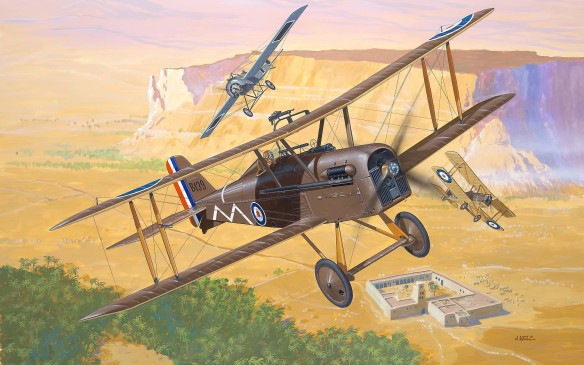Regarded by many as the best British fighter of World War 1, the Royal Aircraft Factory SE5a was less nimble than its frontline contemporary, the Sopwith Camel, but could out-dive and out-climb its `rival’, sustain more combat damage and yet remain intact despite performing high-g manoeuvres. As the fastest British aircraft of its time, it soon became a firm favourite amongst the leading British and Empire aces of World War 1. Indeed, men such as James McCudden, Mick Mannock, Anthony Beauchamp Proctor and George McElroy would all claim more then 40 aerial victories with the SE5/5a.
The development of the RAF SE5/5a and the Sopwith Camel paralleled each other to the point where the prototypes of each machine flew within five weeks of each other. Unlike the squat, light and agile Camel, the SE5 was rakish, angular and heavy in comparison. Yet the latter machine’s tractability meant that it was much easier to fly than the Camel, dived and climbed faster and could withstand severe battle damage.
Royal Aircraft Factory engineers John Kenworthy, Henry P. Folland and Maj Frank W. Goodden designed the SE5 around the promising new Hispano-Suiza 8A V8 engine, the Royal Flying Corps requesting that the scout be robustly built and capable of being flown safely by pilots of limited experience. When the first 21 French-made Hispano- Suiza 8A engines were delivered to the RFC on 20 September 1916, two were used to power the first and second SE5 prototypes, A4561 and A4562. On 28 November the RAF received its first example of the new geared 200hp Hispano-Suiza 8B, which it subsequently installed in the third prototype, A4563, thereby creating the first SE5a.
Tragically SE5 A4562 broke up during a test flight on 28 January 1917, killing its pilot Maj Goodden. Simple modifications corrected the aeroplane’s structural problems, however, and the first production SE5, A4845, cleared its final inspection on 2 March 1917. The first production batch of SE5s did not make a promising impression on their pilots, who complained of poor lateral control – a shortcoming that was alleviated somewhat, but never entirely, by shortening the wingspan and reducing the rake of the wingtips in later production SE5s and SE5as. Engine reduction and gun synchronisation problems also afflicted early SE5s.
The subsequent replacement of the SE5’s 150hp Hispano-Suiza with a more powerful 200hp model, along with further refinements, produced the SE5a, the first of which began arriving at No 56 Squadron in June 1917. Fast, rugged and almost viceless, the SE5a became a mainstay of the RFC and later of the RAF over the Western Front right up to the end of the war. Light on the controls and with innocuous stalling characteristics, the fighter was usefully manoeuvrable yet stable enough for the pilot to shoot accurately at his target. The SE5 was also solidly built, which meant that it could be thrown around the sky during a dogfight without its pilot having to fear the onset of structural failure. It is unsurprising, therefore, that the SE5a was the mount of most of the RFC’s leading aces. The first unit to employ it, `Fighting Fifty-Six’, was also the most successful, being credited with 401 victories by the end of the war, and producing numerous famous aces, two of whom – Albert Ball and James Thomas Byford McCudden – were awarded Britain’s highest military decoration, the Victoria Cross (VC). By the end of World War 1, 2,765 SE5/5as had been built, and some 2,500 more would be completed before production ceased in 1919.
The need for speed
The key to the success of the SE5/5a was its V8 liquid-cooled engine, initially in the form of the direct-drive 150hp Hispano-Suiza 8A. After 77 SE5s had been built with this powerplant, production switched to the SE5a, which was fitted with the geared 200hp Hispano-Suiza 8B engine. Production of this engine under licence by Wolseley Motors Ltd initially proved problematic due to unreliability. Things only started to improve when Wolseley modified a 150hp engine into the high-compression, direct-drive W 4A Viper of 200hp. This engine was vastly superior increasing the SE5a’s top speed by a full 7mph and improving its rate of climb. It was faster, though less manoeuvrable, than the Camel. With the Camel revelling in medium to low altitude combat, the SE5a was the superior aircraft at altitudes exceeding 10,000ft. Therefore, squadrons equipped with the fighter tended to be used more for aerial combat at medium to high altitudes, and much less in the air-to-ground role. Furthermore, the SE5a’s armament of one forward-firing Vickers machine gun in front of the pilot and a single Lewis gun affixed to the top wing made the aircraft ideal for stalking high-flying prey. Pilots could sneak up beneath a hostile machine, ratchet down the gun and fire up into the underbelly of the enemy aircraft.
Specifications (S.E.5a)
General characteristics
- Crew: one
- Length: 20 ft 11 in (6.38 m)
- Wingspan: 26 ft 7 in (8.11 m)
- Height: 9 ft 6 in (2.89 m)
- Wing area: 244 ft² (22.67 m²)
- Empty weight: 1,410 lb (639 kg)
- Loaded weight: 1,935 lb (880 kg)
- Max. takeoff weight: 1,988 lb (902 kg)
- Powerplant: 1 × Hispano-Suiza 8 or Wolseley Viper water cooled V8 engine, 200 hp (150 kW)
Performance
- Maximum speed: 138 mph (222 km/h)
- Range: 300 miles (483 km)
- Service ceiling: 17,000 ft (5,185 m)
- Wing loading: 7.93 lb/ft² (38.82 kg/m²)
Armament
- Guns:
- 1x 0.303 in (7.7 mm) forward-firing Vickers machine gun with Constantinesco interrupter gear
- 1x .303 in (7.7 mm) Lewis gun on Foster mounting on upper wing
- Bombs: 4x 25 lb (11 kg) Cooper bombs, two under each lower wing, to be dropped in 2, 3, 4, 1 order.
